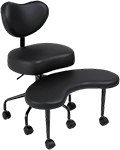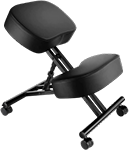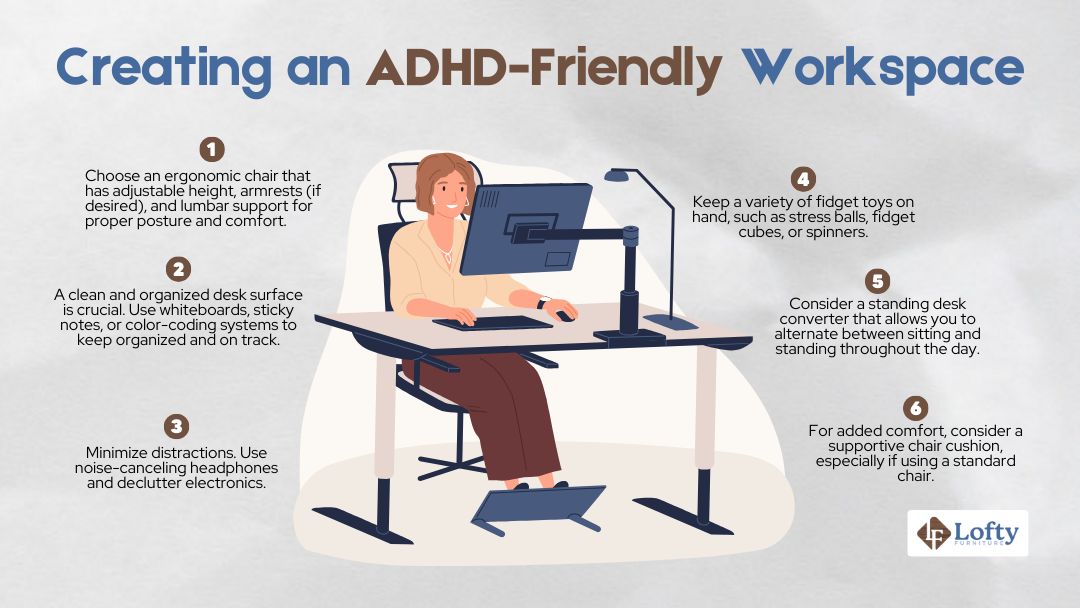Selecting the right chair is crucial for a productive and comfortable workspace. A well-designed ergonomic chair does more than look good: it supports your body, promotes healthy posture, and, for individuals with ADHD, helps sustain focus and productivity. The right ADHD chair can ease restlessness and make it easier to concentrate during long periods of sitting.
Key Takeaways
- The best ADHD chairs are ergonomic, movement-friendly options like wobble stools or active sitting chairs that promote focus and reduce restlessness.
- Utilize features such as lumbar support, seat depth adjustment, and armrests to maintain a neutral posture, alleviate discomfort, and minimize restlessness.
- Combine the chair with regular movement, short breaks, fewer distractions, and simple organization to create an ADHD-friendly workspace.
This article walks you through through the best ergonomic chairs that cater specifically to the needs of those with ADHD. These chairs are designed to enhance comfort, reduce physical strain, and create an environment conducive to sustained attention and efficiency.
Understanding ADHD and Ergonomics
ADHD, or Attention deficit hyperactivity disorder, is a neurodevelopmental condition that affects attention, impulse control, and activity levels. Common symptoms include difficulty focusing, restlessness, and impulsive behavior. While often diagnosed in childhood, ADHD frequently continues into adulthood, influencing productivity, organization, and daily functioning. In the United States, about 6% of adults—roughly 15.5 million people—currently have ADHD, while CDC data show that over 10% of children are affected, underscoring its prevalence across all ages.
Ergonomics can help individuals with ADHD manage restlessness and maintain focus, especially during desk work. Research shows that movement-friendly seating, such as stability or therapy balls, improves on-task behavior by allowing small, controlled movements. For adults, choosing a chair that supports gentle motion—like rocking or a synchro-tilt mechanism—can aid in regulating energy, reducing physical discomfort, and sustaining attention throughout the day.
Best Ergonomic Chairs for ADHD

|
Let’s explore the best ergonomic chairs specifically designed to meet the needs of those with ADHD. These chairs are crafted to provide optimal support, promote movement, and ensure comfort, helping you stay focused and comfortable throughout your day.
Standard Ergonomic Chairs with Adjustable Features
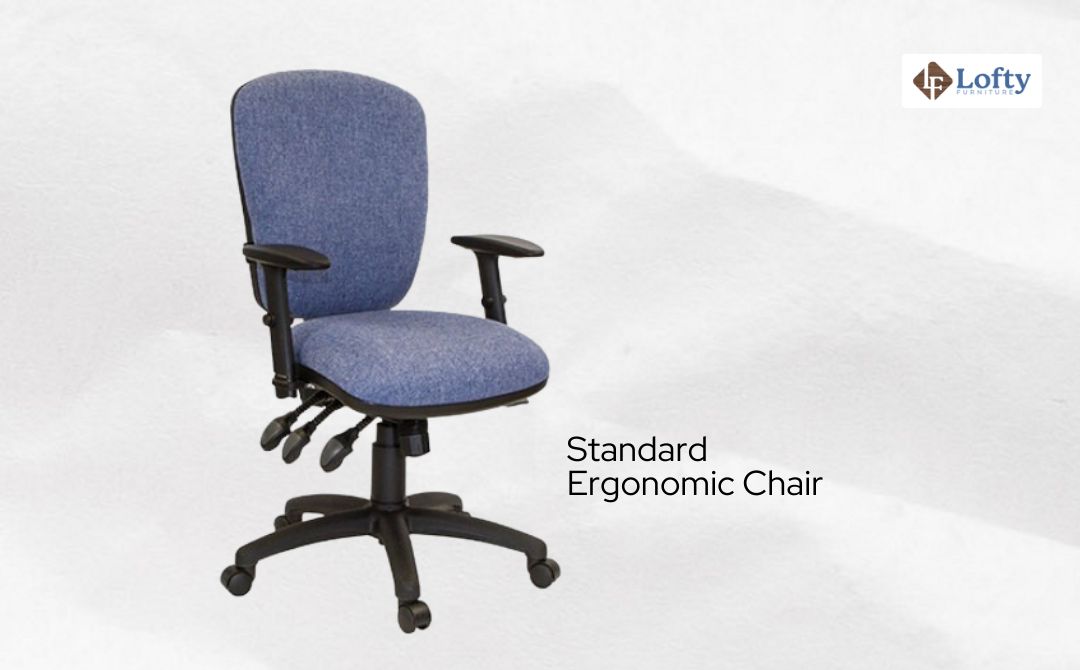
For ADHD, adjustability is essential. Adjustable lumbar support helps keep your spine aligned, improving posture and reducing back pain, especially if you slouch or fidget. Adjustable armrests that move up, down, and sideways keep your shoulders relaxed and prevent neck and upper back strain. A breathable mesh back is also helpful if you tend to get hot or move around, keeping you cool and comfortable all day.
Fit Targets and Safety Notes
- Seat depth: 420–480 mm
- Lumbar height above seat: 160–220 mm
- Armrest height above seat: 180–250 mm
- Armrest width span: 460–510 mm
- Safety: Adjust the tilt tension to allow for smooth reclining without a sudden drop.
Recommended ADHD Chair: High Back Ergonomic Desk Chair with Adjustable Lumbar Support
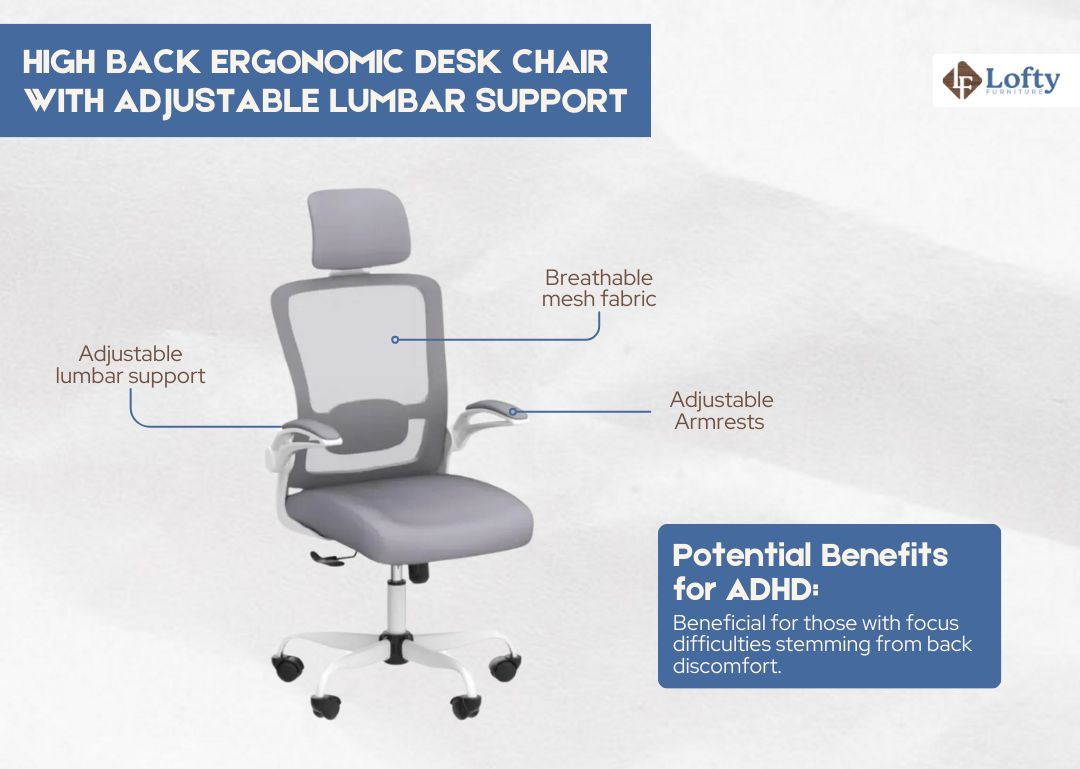
The High Back Ergonomic Desk Chair with Adjustable Lumbar Support is a popular choice for office environments, offering various adjustable features for good posture and comfort. With proper lumbar support, this chair reduces strain on the lumbar discs and promotes healthy spinal curvature, which is particularly beneficial for individuals with ADHD prone to slouching. The seat’s sufficient padding provides comfort, while the breathable mesh back ensures airflow to prevent overheating.
Meditation Chairs

Meditation chairs use an inclined seat and a supportive backrest to encourage an upright posture. This design helps people with ADHD who struggle to maintain spinal alignment in standard chairs. Many models let you sit cross-legged or Indian style, a position that often feels comfortable for ADHD. Sitting in this position engages your core and can help improve focus.
Fit Targets and Safety Notes
- Seat angle: 5–15 degrees
- Cushion thickness: 40–60 mm
- Safety: Change posture every 20–40 minutes to prevent hip and knee stiffness.
Recommended ADHD Chair: Pipesong Meditation Chair
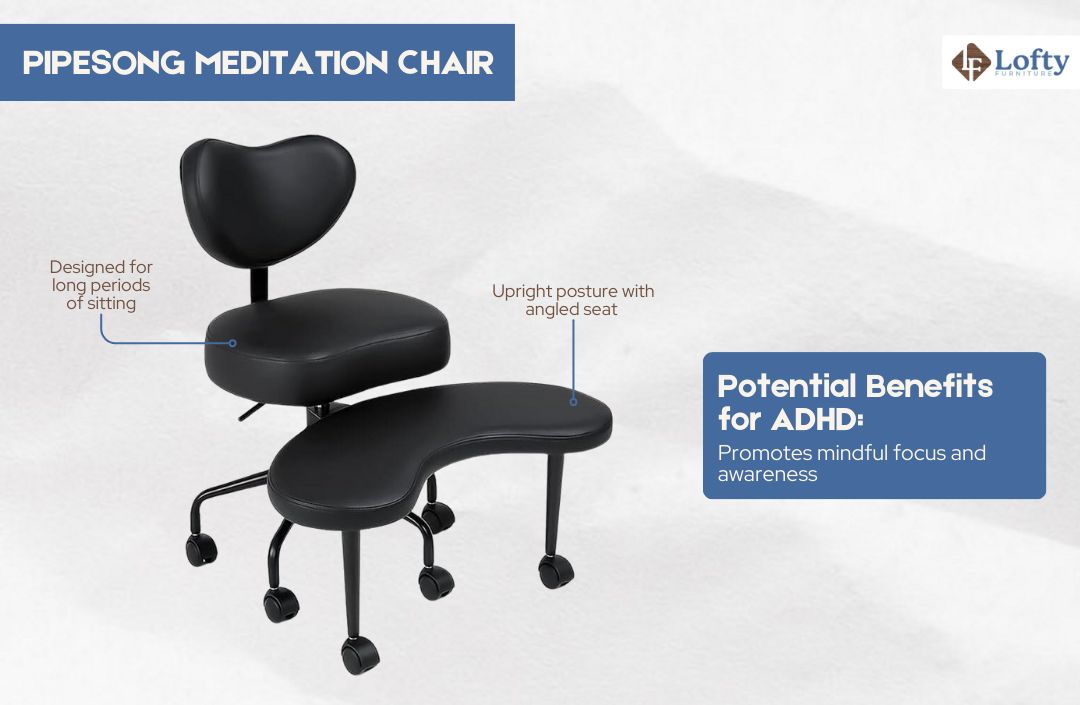
The Pipesong Meditation Chair is known for its comfort and flexibility, especially the Plus model with a larger memory foam seat for longer use. It supports various sitting positions—cross-legged, kneeling, or squatting—great for people with ADHD who need to move often. Its swiveling footrest and flexible design encourage natural movement, while the crescent-shaped backrest provides strong lumbar support to reduce strain. For an active, adaptable seat, this chair is a great option.
Balance Ball Chairs
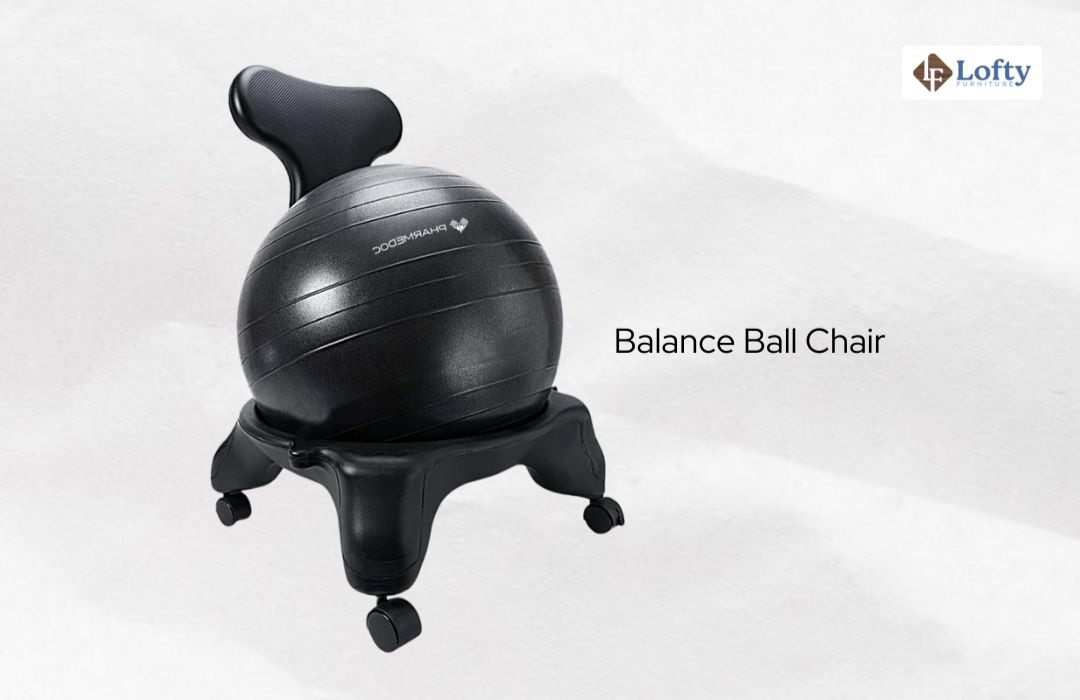
Balance ball chairs, also known as exercise or yoga ball chairs, offer an active sitting option that many adults with ADHD find appealing. Maintaining your balance engages the core, which can enhance body awareness (increased proprioception) and promote better posture. The ball’s unstable surface encourages small, continuous movements throughout the day. This gentle activity can help some people stay alert and maintain attention during seated work.
Fit Targets and Safety Notes
- Ball size matched to stature.
- Use a stable base when working at a desk.
- Safety: Use on low-pile surfaces, park the chair when standing, and limit to 20–40 minute blocks.
Recommended ADHD Chair: Gaiam Classic Balance Ball Chair
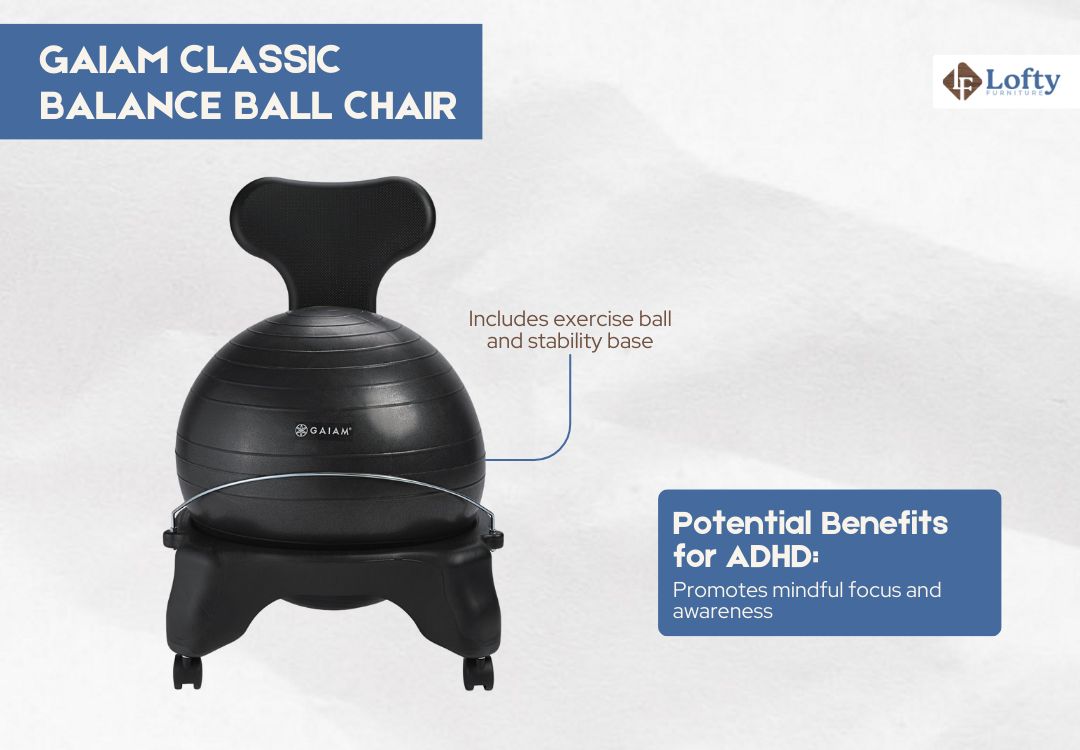
The Gaiam Classic Balance Ball Chair is popular for its stability, easy setup, and ability to boost focus through gentle micro-movements—great for people with ADHD. This subtle activity keeps you engaged and alert whether at home, school, or work. Designed for users 5′ to 5’11”, taller individuals can add leg extenders. It features a removable 52 cm exercise ball, sturdy base, support bar, and metal ball holder, making it an easy way to add active seating to your routine.
Kneeling Chairs
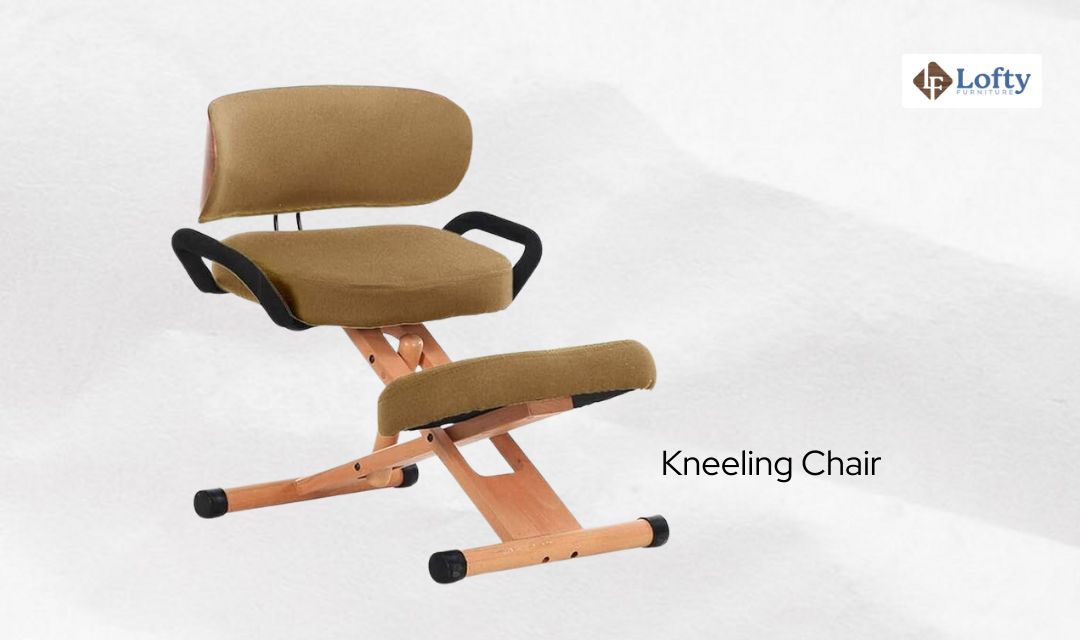
Kneeling chairs provide a unique seating option that can benefit some people with ADHD. By angling the seat forward and supporting the shins, they encourage an upright posture and help maintain proper spinal alignment. These chairs shift some weight from the lower back to the knees and shins, reducing pressure on the lumbar spine. This can ease back pain during long periods of sitting.
Fit Targets and Safety Notes
- Seat angle: 20–30 degrees
- Rocking arc: small and controlled
- Safety: Introduce in 15–30 minute blocks and rotate with a standard chair to reduce shin pressure.
Recommended ADHD CHair: Starla Adjustable Ergonomic Kneeling Chair
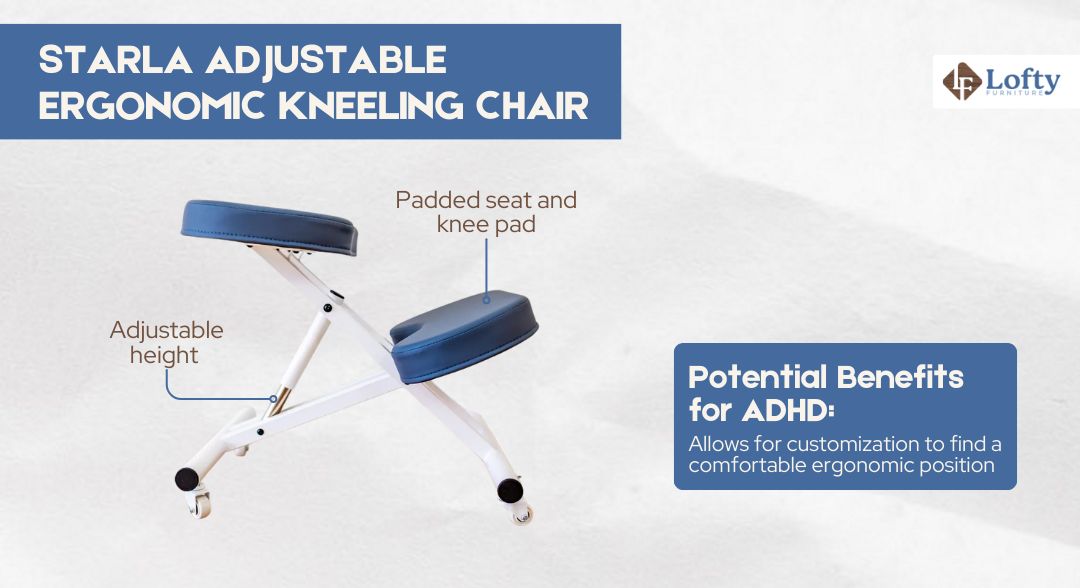
The kneeling design of the Starla Adjustable Ergonomic promotes an upright posture, beneficial for individuals with ADHD who struggle with traditional chairs. This improved posture can increase focus and energy. It also features good padding on the seat and knee pads, and the breathable mesh backrest provides added comfort during extended periods of sitting.
As Dr. Sean Ormond of Atlas Pain Specialists notes:
“For individuals with ADHD, staying focused while sitting for long periods can be a challenge. Chairs with active sitting features or a slight rocking or tilting mechanism allow for gentle movement, helping to channel restlessness in a controlled way.”
Explore our list of 5 best kneeling chairs for 2026.
Key Features of Ergonomic Chairs for ADHD
Individuals with ADHD can benefit greatly from ergonomic chairs that promote good posture, reduce discomfort, and allow for some movement. Here are some key features of ergonomic chairs and how they can improve focus and comfort for those with ADHD:

1. Adjustable Height and Armrests
A height-adjustable chair helps you find the right ergonomic position by keeping your feet flat, knees at 90 degrees, and forearms parallel to the desk. This alignment reduces muscle strain and discomfort, improving focus. Adjustable armrests further support your arms and shoulders, easing tension and fatigue.
As Jung Baccam FNP-BC at Atlas Ketamine notes:
“For individuals with ADHD, choosing an ergonomic chair that supports focus and reduces restlessness is key. Look for chairs that allow for easy movement and adjustments. Chairs with a dynamic seat that allows slight rocking or shifting can help engage both the body and mind without causing discomfort.”
2. Lumbar Support
A chair with adjustable lumbar support provides crucial support for your lower back’s natural curve. This helps maintain proper spinal alignment and reduces pressure on the lumbar spine, which can contribute to discomfort and back pain. Reduced back pain and improved spinal alignment can significantly enhance focus by minimizing distractions caused by discomfort. Additionally, proper lumbar support can help you maintain a more upright posture, which can further improve alertness and concentration.
3. Stability and Mobility (Swivel Base, Wheels)
A stable chair with a wide base ensures safety and prevents the chair from tipping unexpectedly. A swivel base allows for micro-movements throughout the day, which can be beneficial for some individuals with ADHD who find fidgeting helps them focus. Wheels offer the convenience of reaching different areas of your workspace without interrupting your focus.
4. Breathable Materials
Breathable materials like mesh fabric allow for air circulation, preventing moisture build-up and keeping you cool during extended periods of sitting. This reduces discomfort and sweating, which can be distracting and contribute to fatigue. Staying cool and comfortable throughout the day also minimizes distractions caused by overheating and sweating.
How to Choose the Right Ergonomic Chair for ADHD
Finding the right ergonomic chair for individuals with ADHD involves clarifying your needs and preferences, trying a few options, and considering your specific workspace. Here’s a quick guide to get you started:
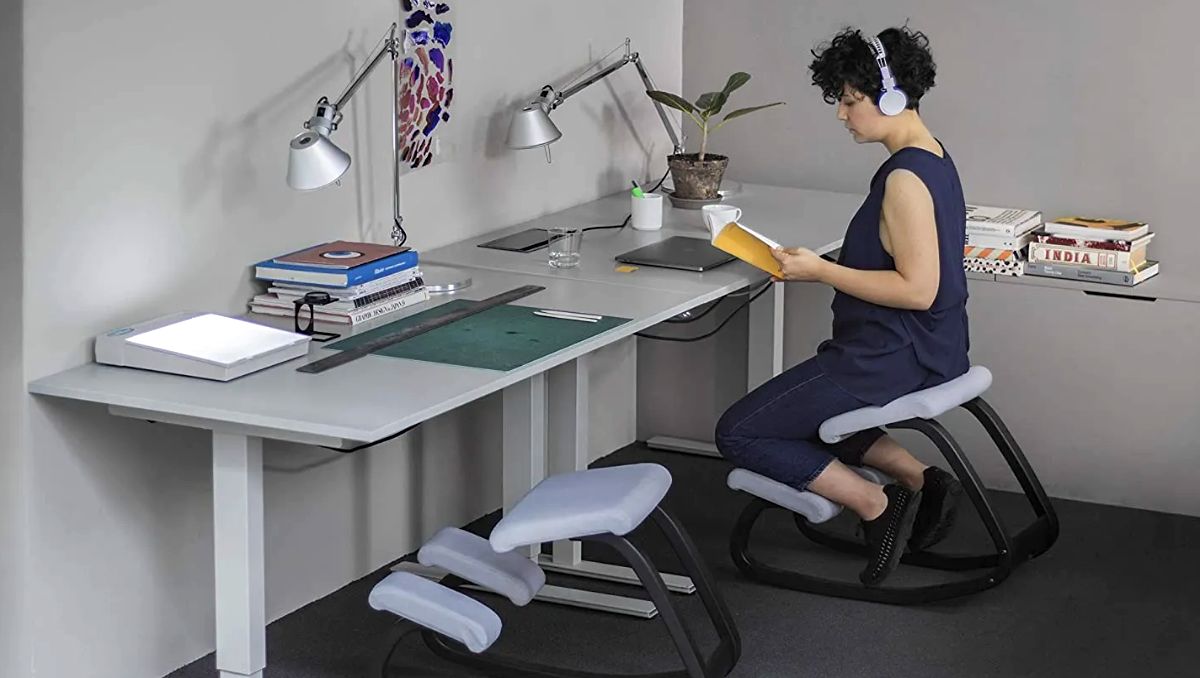
1. Assess Personal Needs and Preferences
Decide if you prefer a chair that allows small movements to stay engaged or a stable design for focus. Consider comfort, adjustability, and your budget. Good options exist at various price points.
2. Considerations for Different Environments
At home, you can choose features like headrests or wider seats for comfort. In traditional offices, prioritize lumbar support and breathable materials. If you move often, look for a lightweight, portable chair with good back support.
4. Consult Experts
Consult ergonomic specialists or ADHD professionals for personalized chair recommendations based on your needs and work environment.
Strategies for Focus and Comfort with ADHD

An ergonomic chair can be a great foundation for improving focus and comfort with ADHD, but it’s just one piece of the puzzle. Here are some additional strategies to consider:
Importance of Regular Breaks and Movement
Our bodies are not designed for extended periods of sitting. Taking regular breaks throughout the day is crucial for individuals with ADHD. Set a timer to remind yourself to get up and move every 30-60 minutes. Walk around, stretch, do some light exercises, or even take a quick walk outside. This movement improves blood flow, reduces fatigue, and enhances focus and concentration upon returning to your work.
Creating an ADHD-Friendly Workspace
- Minimize distractions. This could involve decluttering your workspace, using noise-canceling headphones, or working in a quiet area.
- Visual organization can be helpful. Use whiteboards, sticky notes, or color-coding systems to keep yourself organized and on track.
- Fidget toys can be a valuable tool for some individuals with ADHD. Fidgeting can help them focus and release excess energy.
- Consider a standing desk to alternate between sitting and standing throughout the day. This can promote movement and potentially improve focus.
Here’s a breakdown of the key elements you can use to illustrate an ideal ADHD-friendly workspace setup:
Conclusion
Selecting the best ergonomic chair for individuals with ADHD is a key step toward a workspace that supports focus and comfort. Match your focus style with core features like back support and adjustability, then test options to find a precise fit to boost productivity and well-being.
An ergonomic chair is only one part of the setup. Pair it with regular movement breaks, simple organization, and personal focus tools to sustain attention throughout the day. If you are ready to put this into practice, examine curated chairs and desk pairings at Lofty Furniture. Their focus on quality, adjustability, and long-term comfort makes them a strong partner when building an ADHD-friendly workspace that you can rely on.
Frequently Asked Questions (FAQs)
Are gaming chairs suitable for adults with ADHD, or should I opt for an office chair instead?
Either can work if the model offers genuine ergonomics, including adjustable lumbar support, armrests, seat depth/height, and a supportive recline. Some gaming chairs meet these needs and perform well for extended sessions; others prioritize style over comfort. Compare adjustability and support first, not the category label.
Do I need a BIFMA-certified chair?
Not required, but Business and Institutional Furniture Manufacturers Association (BIFMA) compliance is a helpful signal for durability and safety. You can also search the industry registry to verify products that meet the standards.
Can I request an ergonomic chair as a workplace accommodation for ADHD?
Yes. ADHD can qualify for a reasonable accommodation. The Job Accommodation Network outlines how to initiate the interactive process and lists ergonomic seating as a common solution.
Is a footrest worth adding when buying a chair online?
Often, yes, especially for shorter users or those with fixed-height desks. A footrest helps keep the feet planted, reduces thigh and back strain, and allows for small posture adjustments that improve comfort during prolonged sitting.
If I cannot afford a new chair, what low-cost tweaks would help the most?
Begin with an ergonomic review, then add targeted supports, including a lumbar cushion, a seat cushion, a footrest, and precise adjustments for arm and seat height. These deliver much of the benefit of a new chair when budgets are tight.


